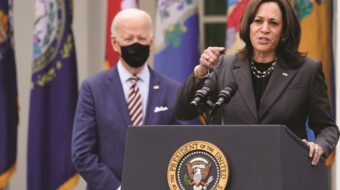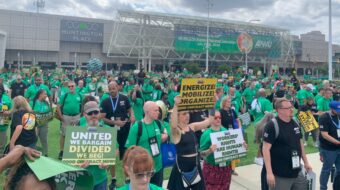CHICAGO — Despite a monthlong million-dollar campaign to scare residents into opposing the “big box” living wage ordinance passed by the City Council July 26, a new poll of Chicago voters shows overwhelming support for the legislation.
Wal-Mart, Target and Mayor Richard Daley have mounted a blitz to turn public opinion against the ordinance. Daley is seeking to switch the votes of two aldermen to sustain his expected veto.
The ordinance calls for raising wages of “big box” retail workers to $10 an hour with $3 an hour in benefits by 2010. It covers all stores of 90,000 square feet or more and companies that do at least $1 billion in sales annually.
In the poll, 71 percent of voters supported the ordinance. Support was strong across the city, with 63 percent among whites, 81 percent among African Americans and 80 percent among Latinos.
In addition, 68 percent said they would look unfavorably at aldermen who voted against the ordinance but then voted themselves a pay raise at the same meeting. Municipal elections are next February. For the first time in many years Daley and several aldermen are vulnerable.
The campaign to undo the vote has been relentless. Target and Wal-Mart announced they were freezing plans for new stores in the city. Full-page ads have appeared in several newspapers. Over 200,000 residents received phone calls trying to convince them that the city would lose jobs and millions of dollars in revenues.
But ordinance supporters aren’t backing down an inch.
On Labor Day, the Chicago Federation of Labor honored the 35 aldermen who voted for the ordinance as “living wage warriors.”
At an Aug. 30 rally at Daley’s office to announce the poll results, Flora Johnson, a homecare worker and member of SEIU Local 880, declared, “We demand that Mayor Daley not steal the big box ordinance.”
Alderman Ricardo Muñoz blasted the big-business-directed campaign. “We are talking about the lie of corporate America,” he said. “They say they can’t pay a living wage because we will lose jobs. They said the same thing in 1997 when we passed the living wage ordinance. Not one job was lost.”
Aldermen organized a hearing Aug. 17 where Santa Fe, N.M., Mayor David Cross and San Francisco Supervisor Tom Ammiano testified. Both cities have minimum wage ordinances for businesses, including those employing 25 or more workers in Santa Fe. The two officials testified the ordinances have not scared off big box retailers. The Aug. 30 rally coincided with the opening of a new Lowe’s store in Santa Fe.
Ordinance supporters demonstrated Aug. 16 in front of a South Side Target store to spotlight that the giant corporation had received nearly $10 million in subsidies from the city.
Meanwhile a study by economists at the University of Illinois at Chicago underscored the “hidden cost of low-wage work.” Each year taxpayers pay $2 billion for public assistance to low-wage workers and their families who need food stamps, Medicaid and child care assistance. UIC researchers say low-paying jobs, including at big box stores, force almost a half-million Illinois families onto public assistance.











Comments